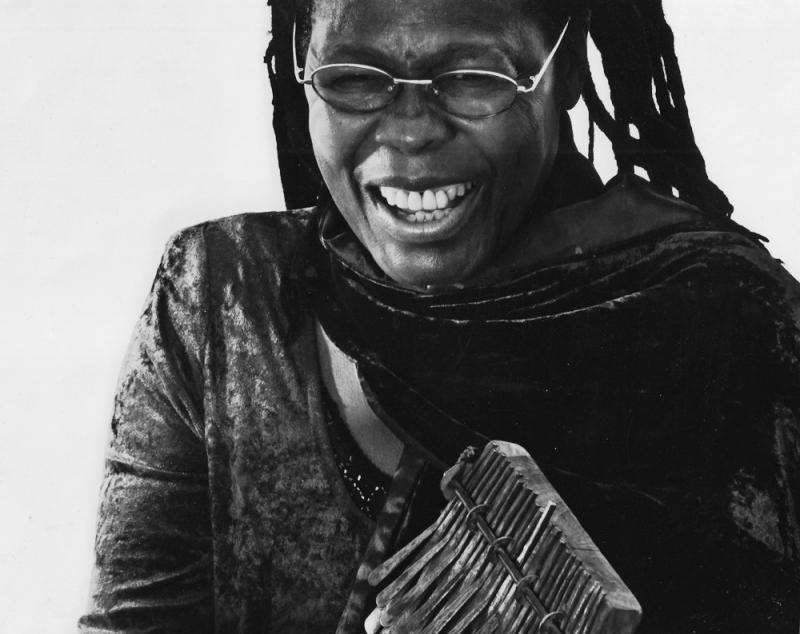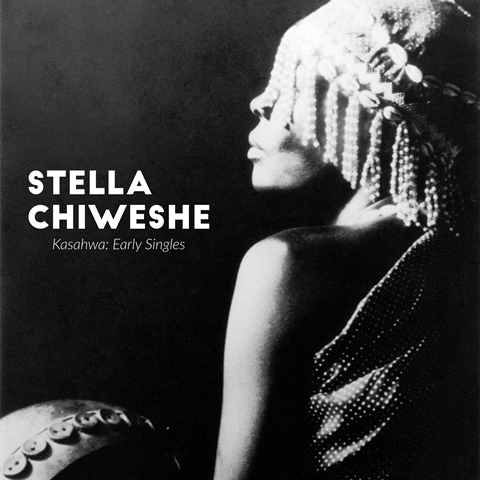Reissue CDs Weekly: Stella Chiweshe | reviews, news & interviews
Reissue CDs Weekly: Stella Chiweshe
Reissue CDs Weekly: Stella Chiweshe
‘Kasahwa: Early Singles’: joyful collection of previously obscure tracks by Zimbabwe’s mbira marvel

Until now, hearing the extraordinary “Ratidzo” was all-but impossible. The original single is rare and has not been reissued before. It begins with a plaintive whistle which sets the scene for a hypnotic and beautiful rotating pattern of single notes possibly played on a gamelan-style instrument. Rhythmic accompaniment comes from a form of shaker.
Chiweshe would reach beyond her home country when she and her band Earthquake were heard on the 19 March 1988 John Peel Show. The four-track session was played during a show which roamed through “Goin' Home” by Ken Colyer's Jazzmen, hip hop from Rob Base and D.J. E-Z Rock, Morrissey’s "Margaret on the Guillotine” and British indie fare from 14 Iced Bears, McCarthy and Stump. A typically eclectic show, then.
 Chiweshe was in the UK following the release of her first album Ambuya?, which came out in Britain on the Globe Style label in 1987. Its sub-title was “Zimbabwe's Queen of the Mbira”, a reference to the hand-held instrument with a wooden, usually resonant, base onto which are fixed a series of springy metal bars. Plucking each with the thumbs produces individual notes. The mbira also featured in the musical arsenal of fellow Zimbabwean Thomas Mapfumo, another of Peel’s favourites.
Chiweshe was in the UK following the release of her first album Ambuya?, which came out in Britain on the Globe Style label in 1987. Its sub-title was “Zimbabwe's Queen of the Mbira”, a reference to the hand-held instrument with a wooden, usually resonant, base onto which are fixed a series of springy metal bars. Plucking each with the thumbs produces individual notes. The mbira also featured in the musical arsenal of fellow Zimbabwean Thomas Mapfumo, another of Peel’s favourites.
Kasahwa: Early Singles is a new eight-track compilation by Chiweshe drawing from singles released by the Shungu and Zimbabwe labels before her international breakthrough. Nothing collected has been previously reissued. She is heard in the raw – this eerie, spectral music is very different to that of Ambuya?
Within the pre-independence country, Chiweshe was an anomaly. No man would make a mbira for her. It was the instrument of the majority Shona group, and women were not meant to play it. No man would teach her to play. Nonetheless, she began playing and recording in the early 1970s. The earliest tracks on Kasahwa were issued by the independent Shungu label and pressed by the Teal Recording Company, a Bulawayo-based EMI subsidiary founded in 1959. Shungu was an early home of The Green Arrows, the first local band to issue an album. Thomas Mapfumo’s Hallelujah Chicken Run Band was also on Shungu. As a female musician Chiweshe was a rarity, but the music business infrastructure around her was, though evolving, one which was established.
Based on what’s heard here – she has said that she recorded over 20 singles between 1975 and 1978 – Chiweshe was already fully formed before she reached European ears in the second half of the 1980s. Each of the eight tracks is so compelling that it is impossible not to be affected by their quiet power. However, they are raw and sparse, and bear little relationship with much of the polished material issued from 1987 onwards.
 It is frustrating that what’s collected on Kasahwa is blithely described as “spanning the period 1974 to 1983,” with “Kasahwa” itself noted as being her debut single and originally released in 1974. It is essential to know when these singles were issued, especially with the context of Zimbabwe becoming independent in 1980. The booklet has a few paragraphs of text, but lacks liner notes as such.
It is frustrating that what’s collected on Kasahwa is blithely described as “spanning the period 1974 to 1983,” with “Kasahwa” itself noted as being her debut single and originally released in 1974. It is essential to know when these singles were issued, especially with the context of Zimbabwe becoming independent in 1980. The booklet has a few paragraphs of text, but lacks liner notes as such.
Once it is accepted that “Kasahwa” and its A-side “Nhemamusasa” were released in 1974 and with the additional knowledge that the “Gomoriye” / “Gwendurugwe” single was subsequently issued by the same label, it appears these four tracks were issued before independence. The “Mayaya Part 1” / “Mayaya Part 2” (edited together as one track here) and the “Musarakunze” / “Chipindura” singles have catalogue numbers between those of other performer’s singles on the same label issued in 1980 and 1988, so the tracks therefore must be post-independence. Similar inferences with the track “Ratidzo” cannot be made as there is no image of the single in the booklet. “Gomoriye” and “Gwendurugwe” were produced by an “A K Mapfumo” – a name which also appears on Thomas Mapfumo records. Is there a familial relation to Thomas Mapfumo?
Kasahwa’s issuing label ought to have detailed the sources, stated when the tracks were issued and how they relate to each other (more precisely than the deductions made here). Buyers want to know these things. They are selling points. Setting this aside, Kasahwa: Early Singles reveals a side to Stella Chiweshe which previously was barely known. It is a joy.
- Next Week: Keychains & Snowstorms – the significant 10-disc Soft Cell box set
Explore topics
Share this article
The future of Arts Journalism
You can stop theartsdesk.com closing!
We urgently need financing to survive. Our fundraising drive has thus far raised £49,000 but we need to reach £100,000 or we will be forced to close. Please contribute here: https://gofund.me/c3f6033d
And if you can forward this information to anyone who might assist, we’d be grateful.

Subscribe to theartsdesk.com
Thank you for continuing to read our work on theartsdesk.com. For unlimited access to every article in its entirety, including our archive of more than 15,000 pieces, we're asking for £5 per month or £40 per year. We feel it's a very good deal, and hope you do too.
To take a subscription now simply click here.
And if you're looking for that extra gift for a friend or family member, why not treat them to a theartsdesk.com gift subscription?
more New music
 Music Reissues Weekly: Sly and the Family Stone - The First Family: Live At Winchester Cathedral 1967
Must-have, first-ever release of the earliest document of the legendary soul outfit
Music Reissues Weekly: Sly and the Family Stone - The First Family: Live At Winchester Cathedral 1967
Must-have, first-ever release of the earliest document of the legendary soul outfit
 Album: Robert Plant - Saving Grace
Mellow delight from former Zep lead
Album: Robert Plant - Saving Grace
Mellow delight from former Zep lead
 Brìghde Chaimbeul, Round Chapel review - enchantment in East London
Inscrutable purveyor of experimental Celtic music summons creepiness and intensity
Brìghde Chaimbeul, Round Chapel review - enchantment in East London
Inscrutable purveyor of experimental Celtic music summons creepiness and intensity
 First Person: Musician ALA.NI on how thoughts of empire and reparation influenced a song
She usually sings about affairs of the heart - 'TIEF' is different, explains the star
First Person: Musician ALA.NI on how thoughts of empire and reparation influenced a song
She usually sings about affairs of the heart - 'TIEF' is different, explains the star
 Album: NewDad - Altar
The hard-gigging trio yearns for old Ireland – and blasts music biz exploitation
Album: NewDad - Altar
The hard-gigging trio yearns for old Ireland – and blasts music biz exploitation
 Album: The Divine Comedy - Rainy Sunday Afternoon
Neil Hannon takes stock, and the result will certainly keep his existing crowd happy
Album: The Divine Comedy - Rainy Sunday Afternoon
Neil Hannon takes stock, and the result will certainly keep his existing crowd happy
 Music Reissues Weekly: Robyn - Robyn 20th-Anniversary Edition
Landmark Swedish pop album hits shops one more time
Music Reissues Weekly: Robyn - Robyn 20th-Anniversary Edition
Landmark Swedish pop album hits shops one more time
 Album: Twenty One Pilots - Breach
Ohio mainstream superstar duo wrap up their 10 year narrative
Album: Twenty One Pilots - Breach
Ohio mainstream superstar duo wrap up their 10 year narrative
 Album: Ed Sheeran - Play
A mound of ear displeasure to add to the global superstar's already gigantic stockpile
Album: Ed Sheeran - Play
A mound of ear displeasure to add to the global superstar's already gigantic stockpile
 Album: Motion City Soundtrack - The Same Old Wasted Wonderful World
A solid return for the emo veterans
Album: Motion City Soundtrack - The Same Old Wasted Wonderful World
A solid return for the emo veterans
 Album: Baxter Dury - Allbarone
The don diversifies into disco
Album: Baxter Dury - Allbarone
The don diversifies into disco
 Album: Yasmine Hamdan - I Remember I Forget بنسى وبتذكر
Paris-based Lebanese electronica stylist reacts to current-day world affairs
Album: Yasmine Hamdan - I Remember I Forget بنسى وبتذكر
Paris-based Lebanese electronica stylist reacts to current-day world affairs
